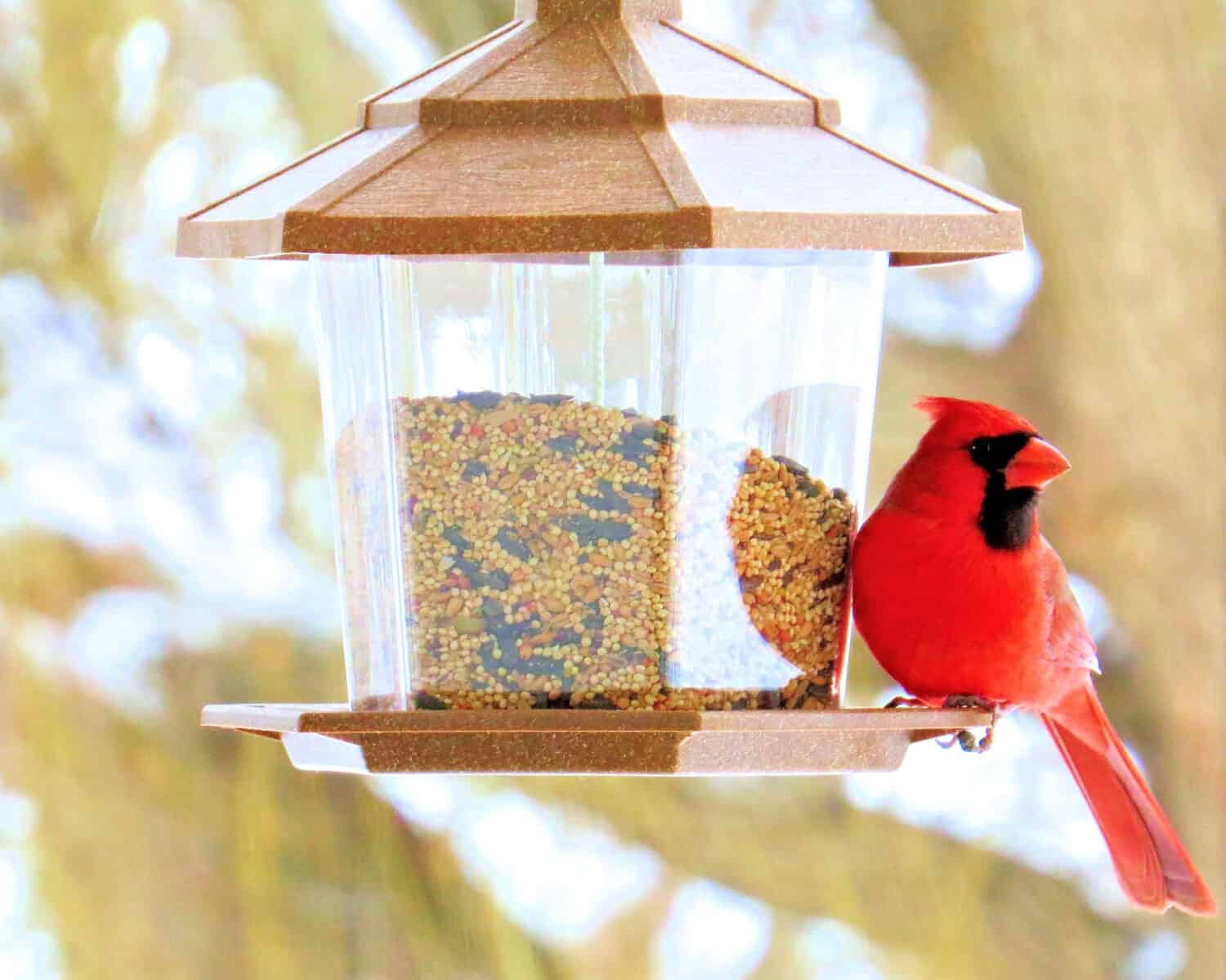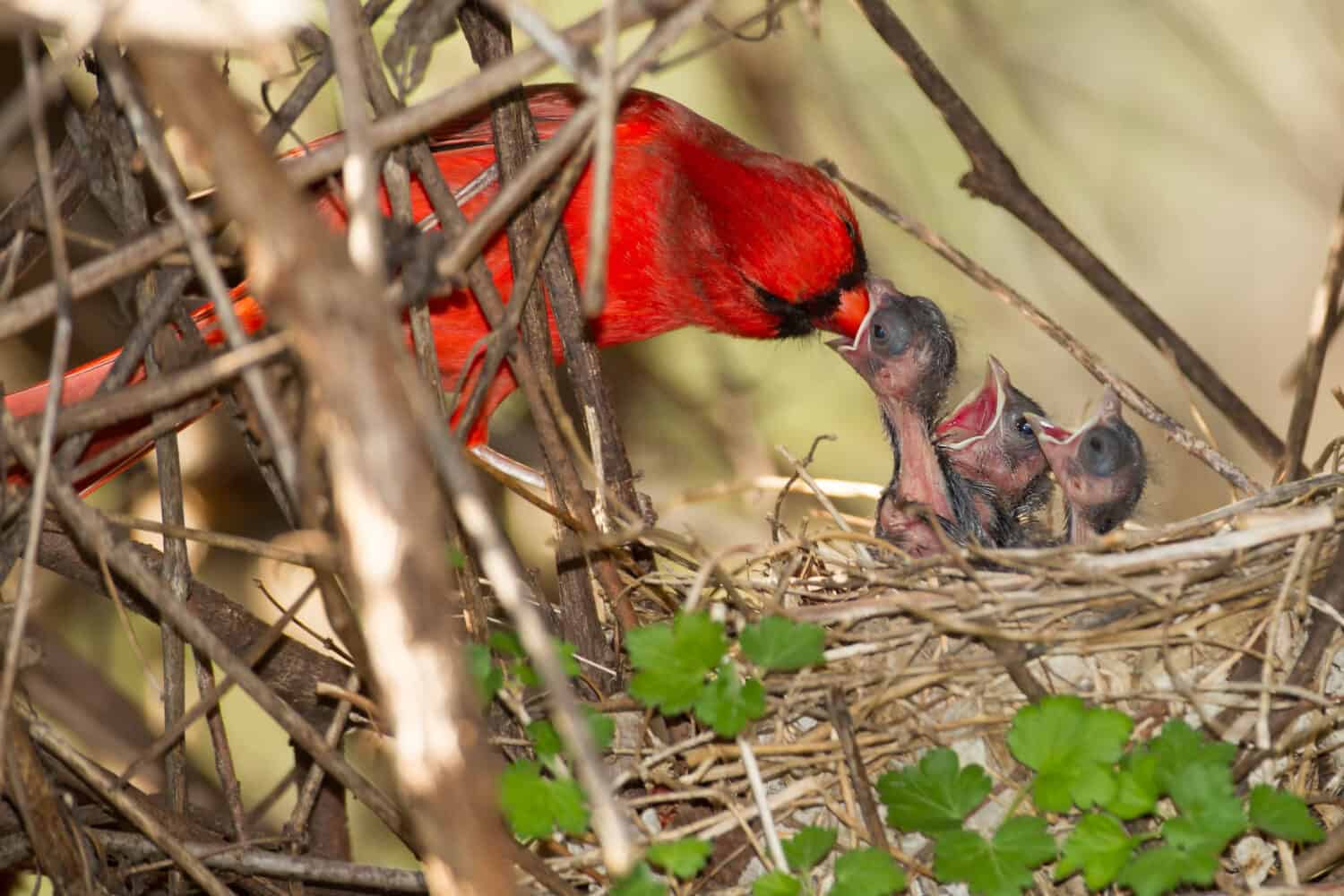The official Virginia State bird is the northern cardinal. Actually, seven states share Cardinalis cardinalis as its avian symbol. In addition to Virginia, the northern cardinal is the state bird of the Eastern and Midwestern states of:
- West Virginia
- North Carolina
- Ohio
- Kentucky
- Indiana
- Illinois
Read on to learn all about the northern cardinal, including when and where best to spot it in Virginia.
How to Recognize the Northern Cardinal
The male northern cardinal is instantly recognizable by its bright red color, which is called “cardinal red.” The vibrant hue makes it easy to spot these birds, which are quite common throughout Virginia and other states.

Male cardinals are a bright scarlet hue known as “cardinal red.”
©Bonnie Taylor Barry/Shutterstock.com
Female cardinals are a drab brown color, with red tufts and wing feathers. Both males and females have black around their bright orange beaks, while juveniles’ beaks are black or dark brown-black. As they get older, young cardinals’ beaks turn the signature orange of adult males and females.
The full-grown northern cardinal measures 8-9 inches long on average. Cardinals are some of the largest backyard birds found in Virginia. In comparison, the chickadee has a length of only around three inches. A bird that’s close in size and also common to Virginia is the blue jay, with a length ranging from 9 to 12 inches.

The plumage crest of the northern cardinal is another distinctive feature of this Virginia state bird. Another way to recognize the cardinal is by its song. Males and females have different calls, although they sound identical to the untrained human ear. The reason male and female northern cardinals’ singing tones vary is due to hormones.
Cardinals emit whistles that repeat several times before varying their call. These territorial birds perch in tall trees to watch for danger, and the males sound aggressive warnings to potential challengers. The males also have mating songs that attract females. Both males and females emit short, sharp sounds called “chips” that warn of predators and help them find each other.
What Do Northern Cardinals Eat?
Cardinals are omnivores, meaning they eat plants and animals. The bulk of a northern cardinal’s diet is made of seeds and fruits local to its habitat. In Virginia, these birds forage for blackberries, mulberries, buckwheat, corn, and wild grasses. They also dine on insects including crickets, flies, and even centipedes to name just three.

Cardinals eat a diverse diet that includes nuts, berries, insects, and birdseed.
©MLHoward/Shutterstock.com
The state bird of Virginia also enjoys birdseed from feeders. Although cardinals are likely to eat any type offered, they tend to favor black oil sunflower seed above other varieties. Cardinalis cardinalis will eat from feeders where other backyard birds and squirrels also visit.
Northern Cardinal Mating Behavior
Cardinals are monogamous birds that mate for life, raising two broods per year. Mating season typically starts in January and ends in September. In addition to attracting mates through song, males provide female cardinals with nesting materials. Typically, cardinal nests are built from grasses, bark strips, and twigs. Nest lining can include grass and foliage.

Males typically gather nest materials, while females do most of the construction.
©Cathleen Wake Gorbatenko/Shutterstock.com
A few days after the female completes the nest, she lays her eggs. Usually, a female cardinal will lay three or four eggs, which are white and green in color. Incubation lasts between 11 and 13 days on average. During the incubation period, the male brings food to the female so that she doesn’t have to leave the eggs. The first cardinal brood appears around mid-March, while the second comes in July.

Both male and female cardinals feed insects to the hatchlings.
©Agnieszka Bacal/Shutterstock.com
Baby cardinals are cared for by both parents. The male and female cardinals bring insects to their young until the babies are strong enough to fly and forage for their own food. Sexual maturity is reached around one year of age, which is about one-third of a cardinal’s lifespan. In the wild, three years is the average lifespan for a northern cardinal.
It’s worth noting that the oldest known wild cardinal lived to be 15 years old. Cardinal lovers may also be glad to hear the oldest cardinal in captivity lived to an age of 28.5 years.
Best Places to See the Northern Cardinal in Virginia
There are many places to spot the state bird of Virginia. Many cardinals even stick around for winter, so you can see them during the snowy season. These eye-catching birds frequent shrubs and trees of all kinds. You might spot them perched on wires in towns and cities.

Northern cardinals are one of the easiest birds to spot in Virginia.
©Brian Lasenby/Shutterstock.com
They’re also regular visitors to any yard where birdseed can be found. If you’ve got fruiting trees in the vicinity, you’re likely to see plenty of cardinals. Like most wildlife, these birds stay close to food supply and safe nesting spots. Because they eat almost anything, it’s easy for the amateur birdwatcher to see plenty of northern cardinals throughout Virginia.
Are Northern Cardinals Endangered?
Northern cardinals aren’t endangered. In fact, they’ve grown in number. This may be due to humans providing food and shelter for these beloved state birds. Cardinals aren’t just native to Virginia, or even the other six states they represent. In fact, you’ll find these birds all over the world in a variety of colors, including yellow and blue. It’s estimated that there are 100,000,000 cardinals in the world, making them a plentiful bird species.
The photo featured at the top of this post is © Steve Byland/Shutterstock.com
Thank you for reading! Have some feedback for us? Contact the AZ Animals editorial team.







